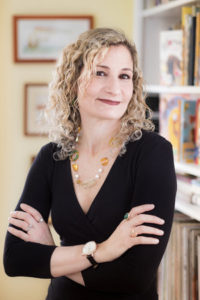 This month’s Editor Interview is with publisher Christy Ottaviano, who runs a boutique imprint at Henry Holt and Company/Macmillan that specializes in making children’s books that “encourage imagination and free-thinking, foster a sense of family and community, target the feelings of children, and speak directly to young people’s interest as they explore various milestones.”
This month’s Editor Interview is with publisher Christy Ottaviano, who runs a boutique imprint at Henry Holt and Company/Macmillan that specializes in making children’s books that “encourage imagination and free-thinking, foster a sense of family and community, target the feelings of children, and speak directly to young people’s interest as they explore various milestones.”
If that’s not reason enough to get her onboard for an Industry Insider interview @ OPB, then try these three facts.
- She’s edited a handful of New York Times bestsellers.
- She’s edited books that have won the National Book Award, the Ezra Jack Keats Award, the E.B. White Award, and the Coretta Scott King Award, among others.
- She has graduate degrees in English and American Literature (Boston College) and Education (Columbia University).
Clearly Macmillan knows what she brings to the table because Christy’s been working for them since 1992! In a publishing world where the only constant seems to be change and transition, that’s a fact that’s nearly impossible to believe. But read on, OPB fans, to find out for yourself what Christy’s secret to success might be.
- Website: http://www.christyottaviano.com/
- Facebook: https://www.facebook.com/christyottavianobooks
- Instagram: https://www.instagram.com/christyottavianobooks/
RVC: Let’s start with a question I’ve never asked before. How did it feel the moment you realized you were going to have your own named imprint at a major publishing house? I’m going to guess that the primary emotion back in 2008 when Christy Ottaviano Books was formed might’ve been…WAHOOO!!!! Am I close?
CO: Haha. Yes, it was a great day. I remember making a conscious decision not to call my partner Kevin with the good news as I wanted to share it in person. I have a long commute, and that night when Kevin picked me up from the train station, I opened the car door, saw my three kids smiling from the backseat (they were very young at the time), and happily jumped in and shared the news. My kids, of course, had no idea what any of it meant but it was a special moment to share with my family.
RVC: When Publisher’s Weekly announced the new imprint, they said it’s going to be 50% picture books, 45% MG and YA, and 5% nonfiction. What’s the ratio look like today? Is there a percentage commitment to certain areas, or is it all about what comes across the transom?
CO: Over the years, I have shifted a bit in some genres. I would say my list is about 45% picture books, 45% middle grade, and 10% YA. I definitely publish more nonfiction these days in both the picture book and middle grade genres–probably by at least 25%. I love nonfiction so this has been a natural step especially now with the market embracing nonfiction much more due to the educational emphasis on STEM.
RVC: Let’s back up a moment to the start of your career. From your college degrees (English/American lit, a French minor, and Education credentials), it seems like you had a different career path in mind. What happened? When did the kidlit bug get you?
CO: I think my career path organically led me to where I am. I always loved reading and writing, and graduated college with an English degree. I went on to pursue a graduate degree in literature with the plan to become a college professor. After getting my master’s in English and American Literature, I taught high school for a year and realized how much I loved teaching creative writing. Around that time I was taking some children’s literature classes at Simmons College and heard an editor speak about her career. Her job’s requirements as an editor seemed like a perfect match for my skills and interests, so I enrolled in a publishing program at Radcliffe College and got my first job in publishing working as an editorial assistant at Henry Holt. But I wasn’t entirely sure it would work out given the competition in the field, so for many years, I took classes after work and obtained a second master’s degree from Teachers College with a plan B to return to education, just in case.
Ironically, this plan proved incredibly formative as I took classes in writing, children’s literature, art history, and painting. All the years I spent in graduate school evaluating text and art definitely helped me grow as an editor. And I credit Macmillan for supporting me in my ascent from editorial assistant to Publisher of my own imprint.
RVC: Why picture books? What about them appeals to you so much?
CO: From an early age, first impressions about story and art are formed by way of this inspiring genre. Picture books are the gateway to reading for young children. It’s a powerful art form and one I feel transcends age as picture book readers tend to be readers for life. It’s a format that I feel can perfectly encapsulate a feeling, a moment, a subject, a place and time.
As cliché as it may sound, picture books have a true magic about them.
RVC: If someone were going to read three of your titles to get a good handle on your picture book sensibility, what three would you recommend?
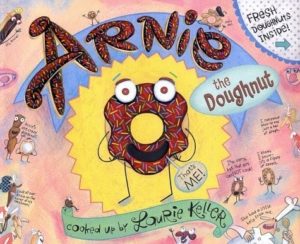 CO: Arnie the Doughnut by Laurie Keller, Same, Same But Different by Jenny Sue Kostecki-Shaw, and Counting on Katherine: How Katherine Johnson Saved Apollo 13 by Helaine Becker, illustrated by Dow Phumiruk.
CO: Arnie the Doughnut by Laurie Keller, Same, Same But Different by Jenny Sue Kostecki-Shaw, and Counting on Katherine: How Katherine Johnson Saved Apollo 13 by Helaine Becker, illustrated by Dow Phumiruk.
RVC: One of the things I see in your imprint’s lineup is a strong sense of diversity of character, theme, and style–and that’s not even taking account Arnie and his awesome donut-ness.
How do you handle when someone’s writing outside of their own direct experiences?
CO: That’s a difficult question to answer because the circumstances differ for each author and with each book. Using sensitivity readers and outside experts has been an important part of my process from the beginning of my career. But also vitally important–I’ve worked hard over the years to develop an aesthetic sense of what makes effective writing and what makes effective art. I use that sense to help me determine if I want to publish a book and how to work with an author in the revision process. As an editor, I bring both an intense closeness to the text as well as a bit of distance, which is crucial. The idea is to enable the author or artist’s work to shine in its best light.
RVC: Something people don’t typically appreciate about the role of an editor is how much research they have to do. How much digging-around time do you put into a new author or manuscript?
CO: Ah, this is the fun part. As mentioned, I publish a good deal of nonfiction, and whenever I’m considering a subject–either pitching it to an author or responding to a submission–I love fully immersing myself in the material to learn as much as I can before I bring the project to the acquisition board. I’m an information junkie and I’m eager to soak up as much as I can on a particular subject. I may not always be up on the newest Netflix shows, but I think I make up for that by reading widely across sources–newspapers, magazines, newsletters, and, of course books. I’m always reading books. Usually two at a time.
RVC: In all of your experience in kidlit publishing, what has surprised you the most?
CO: The talent of writers and artists. I never get tired of reading wonderful words and looking at beautiful images. The talent keeps us all fresh and young and on our toes.
RVC: What’s a current picture book project that’s got you super jazzed?
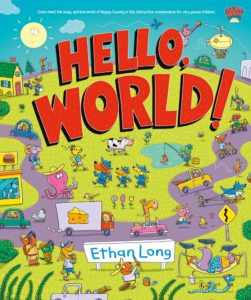 CO: Ethan Long’s Hello, World–the first book in the Happy County series. This is a modern day Richard Scarry-inspired world full of early childhood content that speaks directly to preschoolers. Ethan is a hugely talented storyteller and artist who is also naturally funny. He taps into a child’s mind as he explores many milestone concepts for this age range.
CO: Ethan Long’s Hello, World–the first book in the Happy County series. This is a modern day Richard Scarry-inspired world full of early childhood content that speaks directly to preschoolers. Ethan is a hugely talented storyteller and artist who is also naturally funny. He taps into a child’s mind as he explores many milestone concepts for this age range.
On a personal note, Richard Scarry was my co-pilot when my children were young–his books were able to appeal to all three of my kids when they were between the ages of 1 and 6. Whenever we traveled on vacation I would bring a Busy Book as it would keep all three kids content. Ethan Long’s Hello, World is off to a great start with starred reviews, and we have three more in the pipeline with a plan to publish two a year.
RVC: Richard Scarry was a big hit in my family’s reading repertoire, too. If Ethan’s on that same track, sign me up as a fan.
Okay, this next bit comes with a warning. What’s coming next might just be the most important thing you’ve been asked all week. With that in mind…what’s the update on your beloved 1950s red pool chair from the Flatiron Building? Is retirement on your porch all it dreamed it’d be?
CO: I’m sorry to say it’s still sitting in my sister’s NYC apartment. I brought it there by way of a cab (tight fit!) back in May and I still haven’t gotten myself over to pick it up and drive it back to Connecticut where I live. There is a spot waiting for it on our porch so I need to get on that.
Thanks for the reminder, Ryan!
RVC: Let’s shift gears and jump into the final part of the interview—THE SPEED ROUND! Pithy questions and zip-zappy answers, please. Are you ready?
CO: Bring it on.
RVC: Worst day ever—no social media, no TV, or no books?
CO: Being far away from my family. But, if I’m limited to the choices above—it would be no reading material. When my boys were younger and adored LEGO, they used to say that if I was a mini fig, my accessories would be a cup of tea in one hand and a manuscript or a book in the other. I think that’s pretty accurate.
RVC: If your literary mascot was from the world of picture books, which would it be?
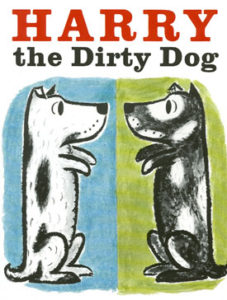 CO: Harry the Dirty Dog.
CO: Harry the Dirty Dog.
RVC: Weirdest job you ever had?
CO: I’m a collector and love affordable antiques and flea market finds. In grad school, I got a job working at the Cambridge Antique Market and loved getting to know all of the dealers. It was intriguing to see the different pieces that came in– such a selection of offbeat finds–everything from Bakelite jewelry from the 1930s to old board games of the 1970s like Clue and Operation, to vintage books, which I love and collect. It was a weird job in the best of ways as I never knew what a day at the market would bring in terms of what pieces would come in–a bit like “Antiques Roadshow.” We would have a lot of fun researching the find, and this was before Google so we had to do lots of digging. I loved it all.
RVC: Coolest picture book from the past year (not published by Macmillan)?
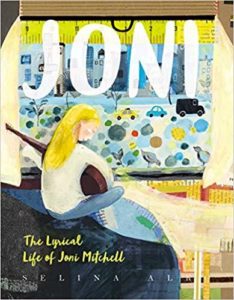 CO: Selina Alko’s picture book on Joni Mitchell. I love picture book biographies and publish widely in this genre. I also love music (who doesn’t?!) and Joni is someone whom I have read a lot about; she’s a fascinating subject. Selina spoke with me a bit about this project as she was working on it as we also publish books together. I’m eager to get my hands on a copy. The jacket is stunning.
CO: Selina Alko’s picture book on Joni Mitchell. I love picture book biographies and publish widely in this genre. I also love music (who doesn’t?!) and Joni is someone whom I have read a lot about; she’s a fascinating subject. Selina spoke with me a bit about this project as she was working on it as we also publish books together. I’m eager to get my hands on a copy. The jacket is stunning.
RVC: If you could change one thing about the world of picture books, what would it be?
CO: I’d like to get picture books into the hands of more readers especially those with limited access.
RVC: Sum up your picture book philosophy in five words or fewer.
CO: Books that make children grow, think imaginatively, and outside the box. Sorry, Ryan–that was double your word count!
RVC: That’s okay–it was worth it. Thanks so much, Christy!

